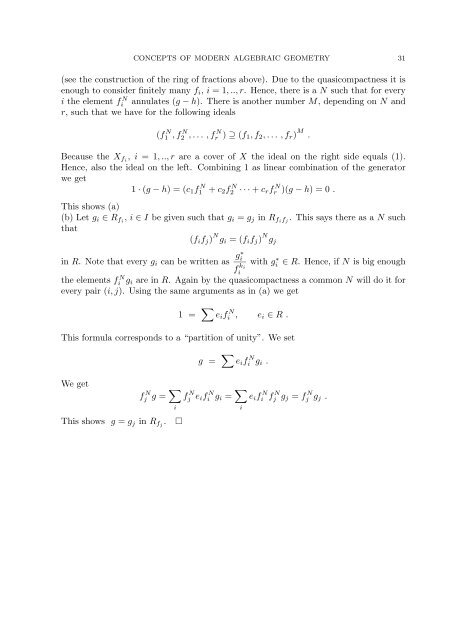Mannheimer Manuskripte 177 gk-mp-9403/3 SOME CONCEPTS OF ...
Mannheimer Manuskripte 177 gk-mp-9403/3 SOME CONCEPTS OF ...
Mannheimer Manuskripte 177 gk-mp-9403/3 SOME CONCEPTS OF ...
- No tags were found...
You also want an ePaper? Increase the reach of your titles
YUMPU automatically turns print PDFs into web optimized ePapers that Google loves.
<strong>CONCEPTS</strong> <strong>OF</strong> MODERN ALGEBRAIC GEOMETRY 31(see the construction of the ring of fractions above). Due to the quasico<strong>mp</strong>actness it isenough to consider finitely many f i , i = 1,..,r. Hence, there is a N such that for everyi the element fiN annulates (g − h). There is another number M, depending on N andr, such that we have for the following ideals(f N 1 ,f N 2 ,... ,f N r ) ⊇ (f 1 ,f 2 ,... ,f r ) M .Because the X fi , i = 1,..,r are a cover of X the ideal on the right side equals (1).Hence, also the ideal on the left. Combining 1 as linear combination of the generatorwe get1 · (g − h) = (c 1 f N 1 + c 2 f N 2 · · · + c r f N r )(g − h) = 0 .This shows (a)(b) Let g i ∈ R fi , i ∈ I be given such that g i = g j in R fi f j. This says there as a N suchthat(f i f j ) N g i = (f i f j ) N g jin R. Note that every g i can be written as g∗ if k iiwith g ∗ i∈ R. Hence, if N is big enoughthe elements f N i g i are in R. Again by the quasico<strong>mp</strong>actness a common N will do it forevery pair (i,j). Using the same arguments as in (a) we get1 = ∑ e i f N i , e i ∈ R .This formula corresponds to a “partition of unity”. We setg = ∑ e i f N i g i .We getf N j g = ∑ if N j e i f N i g i = ∑ ie i f N i f N j g j = f N j g j .This shows g = g j in R fj .□
















